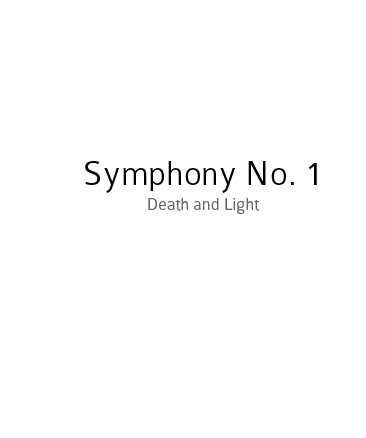

Deeply personal, the subject of this symphony is the interplay and connection of hope and despair. The piece opens with an anguished first movement. It is a cry in the darkness, a turbulent and, at times, overpowering in its distress. The second movement moves the listener into a more meditative outlook, and the third movement marks a hesitant yet spritely change of direction. Resounding tutti chords announce the beginning of the fourth movement and the long-desired return of daybreak and hope.
Time: 36'30"
Click here to read Mr. Isaac's essay on writing the piece.
![]()
Symphony No. 1 is full of the breadth of emotion and angst associated with Beethoven's and Brahms' symphonies. Composed from 2004-2008, the symphony displays great technique, long range development, and strong motific writing. David Isaac adheres to the purity of form and traditional expectations, but taken in the context of the 21st century. Orchestrated with classical restraint, each movement highlights a particular choir of the orchestra. In general, this piece contains bold and noble sentiments with sweeping climaxes. It is grand debut to the symphonic tradition.
I. Lento - Vivace
The movement starts with a haunting low rumbling, giving way to suddenly intense and furious fortissimo strings, their vibrato and intensity only accentuated by the booming timpani. This despairing mood is gripping.
Solo instruments give small moments of brightness and warmth to the concert hall, but even these are tinged by the overwhelming passion of loss. As the movement continues, the frantic movement in the string section only adds to the desperation. In the darkest moments of the piece, a rising surge of strings brings the listener back into the light. But this brightness fades. The ending of this movement does not fade softly into resignation, but instead thunders its misfortune and grief, fueled by the power of a full orchestral tutti.
II. Molto Adagio
This movement is a sensitive and heartfelt expression of devotion and hope. The confident, but gentle, movement of the bows soothe the audience into a more restful state, a peaceful reflection. A solo violin gives an impassioned plea, but, slowly, he rejoins the rest of the string section, and all of the strings move together one last time, in a tender and quiet close.
III. Scherzo
Quick and sharp sounds dart around the hall, effortlessly flowing and returning through the different instruments just as a gust of wind easily changes its direction. It is a light and airy dance of the woodwinds and strings, playfully repeating a favorite phrase. Then, the strings die down, the woodwinds stop their glittering dance, and one flute alone gives its last soft yet happy farewell to the ended celebration.
IV. Allegro
The noble melody of the English Horn, the power of the brass melodies, and the majestic unity of the orchestra: all describe the human spirit's the ability to grapple with adversities like famine, poverty, and death, and to overcome it. The movement depicts the fulfillment of hope, the rebirth after death, and it is a triumphant and glorious ending to a full and satisfying journey.
![]()
This piece is for full orchestra: woodwinds in threes, including piccolo, English horn, bass clarinet, and contrabassoon; the brass section is 4, 3, 2,1; the percussion section includes timpani and one percussionist playing bass drum and large suspended cymbal; and strings. Other arrangements are available upon request.
![]()
This piece may be programmed in fall and winter programs and can close the first or second half.
![]()
Movements 2, 3, and 4 may be used as standalone pieces.
Movement 2: (5'40")
Instrumentation: For string orchestra alone.
Programming Ideas: Works well as moving interlude between symphonic movements. It shares similarities with Barber's Adagio for Strings.
Movement 3: (3'50")
Instrumentation: Reduced size orchestra. Woodwinds in threes; the brass section is 1 horn only; and strings.
Programming Ideas: Works as a filler piece or opener for the second half. It is a short fun piece for the woodwinds.
Movement 4: (9'10")
Instrumentation: Full orchestra.
Programming Ideas: Can be used as an overture. It is an optimistic beginning to a program.
![]()
View Mvt. 1 |
View Mvt. 2 |
View Mvt. 3 |
View Mvt. 4 |
![]()
Contact us for the complete score and or try out Symphony No. 1 in a rehearsal.
We will provide the parts at no cost to you. Rental or purchase fees will apply, only if you decide to perform the music in concert.
Contact David Isaac by email: info@davidimusic.com or by phone 562-285-7608.

